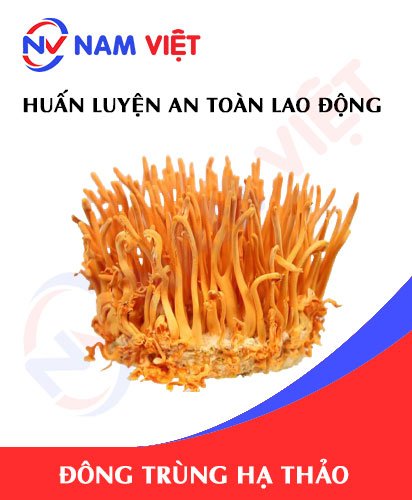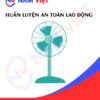Occupational Safety Training in Cordyceps Militaris Manufacturing Factory
99,000 ₫
Note: The above price is calculated for one person, the price may fluctuate depending on the number of trainees participating in the course and the movement of the market. For more accurate pricing support, please refer to the quotation table or contact our consulting staff directly.
Occupational safety is an important issue in cordyceps militaris manufacturing factories and needs to be addressed promptly to ensure the health and safety of workers and enhance the reputation of enterprises. The Occupational Safety Training course is one of the effective solutions to raise awareness about preventing occupational accidents for workers when participating in cordyceps militaris manufacturing.
Table of Contents
Toggle1. Overview of Cordyceps
a. What is Cordyceps?
- Cordyceps is a type of fungus that grows on decaying insects in humid forest areas. Cordyceps (Cordyceps sinensis) is used in traditional medicine in China, Japan, and Korea for disease treatment and health enhancement. Cordyceps is considered one of the most precious and expensive medicinal herbs in the world.
- Currently, the cordyceps manufacturing industry is developing strongly in Vietnam. In recent years, this sector has been included in the list of industries with development potential in the national socio-economic development plan.
- Vietnam has favorable natural conditions for growing and developing cordyceps. According to statistics from the Ministry of Agriculture and Rural Development, Vietnam currently has about 25,000 hectares of land used for cordyceps cultivation. Provinces such as Quang Nam, Quang Ninh, Lao Cai, Ha Giang, Cao Bang, and Lam Dong are the key cordyceps cultivation areas.
- Vietnamese cordyceps products are exported to many countries worldwide, including China, Korea, Japan, the United States, and Europe. However, the cordyceps manufacturing industry still faces many challenges, especially counterfeit and imitation products. To develop the cordyceps manufacturing industry in Vietnam, investment in research and modern technology application is needed to increase productivity and product quality, along with appropriate policies to support people in cultivation and processing.

b. Machinery Used in Cordyceps Processing
Cordyceps is a fungus that grows on insects and has high nutritional value. Cordyceps manufacturing requires investment not only in the cultivation process but also in processing products. After harvesting, cordyceps is dried and processed into different products such as capsules, powder, oil, and beverages.
Common machinery used in cordyceps processing includes:
- Drying Machine: Used to dry cordyceps after harvest. The drying machine must maintain suitable temperature and humidity to ensure product quality.
- Grinding Machine: Used to grind cordyceps into powder. To ensure safety and quality, the grinding machine must be cleaned and maintained regularly.
- Packing Machine: Used to pack cordyceps products into various packaging such as boxes, zip bags, bottles, and jars. The packing machine must ensure safety and accuracy during packaging.
- Juicing Machine: Used to produce cordyceps juice. The juicing machine must be cleaned and maintained regularly to ensure safety and product quality.
- Extraction Machine: Used to extract oil from cordyceps. The extraction machine must be cleaned and inspected regularly to ensure safety and quality.

c. Typical Cordyceps Manufacturing Companies
Currently, there are many cordyceps manufacturing companies in Vietnam, and some typical companies include:
- Vinaca Cordyceps Manufacturing and Trading Co., Ltd.: One of the leading companies in producing, processing, and trading cordyceps products in Vietnam. The company has cordyceps farms and a modern processing factory in Quang Ninh province.
- Vietnam Cordyceps Manufacturing and Trading Co., Ltd.: Specializes in producing and trading cordyceps products with well-known brands such as Viet Moc, Kim Chi, and Korean Red Ginseng. The company has cordyceps farms and processing factories in northern mountainous provinces such as Ha Giang, Cao Bang, and Lang Son.
- Hung Thinh Cordyceps Joint Stock Company: Specializes in producing, processing, and trading cordyceps products such as refined cordyceps, cordyceps powder, cordyceps beverages, and cosmetics. The company has cordyceps farms and a processing factory in Quang Ninh province.
- Vietnam Cordyceps Joint Stock Company: One of the pioneering companies in cordyceps manufacturing and processing in Vietnam, with farms and processing factories in Ha Giang, Cao Bang, and Lang Son provinces.
- Minh Duong Cordyceps Joint Stock Company: Specializes in producing cordyceps products such as cordyceps beverages, powder, and honey. The company has cordyceps farms and a processing factory.
d. Specific Jobs in a Cordyceps Factory
Group 1
- CEO, deputy CEO, department heads in the cordyceps manufacturing factory.
Group 2
- Safety Officers: manage safety in the factory, design safety procedures, supervise, and ensure workers follow safe work processes.
Group 3
- Harvesting Cordyceps: This is the most important task in cordyceps manufacturing. It involves collecting cordyceps from the forest or cultivated on agricultural land.
- Drying Cordyceps: After harvesting, cordyceps is dried to preserve and reduce moisture. This is done by placing cordyceps on drying trays at appropriate temperature and humidity.
- Grinding Cordyceps: After drying, cordyceps is ground into small pieces for use in functional products.
- Mixing Cordyceps with Other Ingredients: To enhance product effectiveness, cordyceps is often mixed with ingredients such as alcohol, honey, ginseng, lotus seeds, lotus leaves, dogwood bark, quartz, etc.
- Packing and Product Manufacturing: After mixing, products are packaged and manufactured into forms such as capsules, powder, beverages, masks, etc.
- Quality Control: Each batch is checked for quality before distribution. Criteria include purity, cordyceps content, other ingredient content, and moisture level.
- Storage and Transportation: Products are stored in warehouses and transported to sales points. Proper storage and transport are necessary to maintain quality and value.
Group 4
- Office, support, sales, and marketing work.
- Production management, quality management, human resources management, materials management, financial and accounting management.
- Research and development of new products and packaging design.

2. Overview of Occupational Safety Training for Cordyceps Manufacturing
In this article, we focus on Group 3 because Group 3 directly participates in the manufacturing process and faces the highest occupational safety risks. Refer to other groups here
a. What is Group 3 Occupational Safety Training?
- Group 3 Occupational Safety Training consists of sessions that equip workers with awareness on preventing workplace accidents.
- The training helps workers identify hazards and avoid risks, reducing the chance of accidents during work.
REGISTER FOR OCCUPATIONAL SAFETY TRAINING SERVICE
b. Training Duration
Initial Safety Training
- Total training duration is at least 24 hours, including testing.
- 8 hours theory on occupational safety and hygiene policies and laws
- 8 hours theory on basic safety and hygiene knowledge
- 4 hours theory on specialized training content
- 2 hours practice on specialized training content
- 2 hours final theoretical test
The safety training center schedules sessions depending on worker availability. Usually, there are 6 sessions completed over 3 days if the factory can allocate continuous training time.
Periodic Safety Training
- Before the occupational safety card expires, workers seeking renewal must undergo periodic safety training, with duration of at least 50% of the initial training duration.
Explanation: total periodic safety training is at least 12 hours, including testing. After completing the course and passing the test, workers will receive a renewed occupational safety card.
c. Training Content
| No. | TRAINING CONTENT | TRAINING DURATION (HOURS) | |||
| Total | Including | ||||
| Theory | Practice | Test | |||
| I | Occupational safety and hygiene policies and laws system | 8 | 8 | 0 | 0 |
| 1 | Overview of legal documents related to occupational safety and hygiene. | 6 | 6 | ||
| 2 | System of standards and technical regulations on occupational safety and hygiene. | 1 | 1 | ||
| 3 | Specific regulations by state authorities on safety and hygiene when constructing, expanding, or renovating facilities, factories, or machinery with strict safety and hygiene requirements. | 1 | 1 | ||
| II | Basic knowledge of occupational safety and hygiene | 8 | 8 | 0 | 0 |
| 1 | Basic knowledge of workplace hazards and harmful factors. | 4 | 4 | ||
| 2 | Methods to improve working conditions. | 1 | 1 | ||
| 3 | Safety culture in manufacturing and business. | 1 | 1 | ||
| 4 | Rights and obligations of employers and employees; policies on occupational safety and hygiene; functions and duties of safety and hygiene staff network. | 1 | 1 | ||
| 5 | Safety rules, signage, use of safety equipment and personal protective equipment; first aid, accident prevention, and occupational disease prevention skills. | 1 | 1 | ||
| III | Specialized training content | 6 | 4 | 2 | 0 |
| Comprehensive knowledge about machinery, equipment, hazardous materials; risk analysis, safety and hygiene management, safe working procedures with machines and materials requiring strict safety and hygiene. | 6 | 4 | 2 | ||
| IV | Final test of safety training content | 2 | 2 | 0 | 0 |
| Total | 24 | 22 | 2 | ||
See more training content of the 6 groups
d. Occupational Safety Card
After completing the occupational safety training and passing the test, workers will be issued a Group 3 Occupational Safety Card (commonly called Group 3 Safety Certificate).
The card shows personal information: full name, date of birth, job, work environment, training duration, red stamp, and signature confirming completion.
According to Clause 2 of Article 24 of Decree 44/2016/ND-CP, there are two cases:
- If the employer and worker have a labor contract, the employer must sign, stamp, and certify the Group 3 safety card after the worker completes training at an occupational safety training unit and passes the test.
- If the worker is freelance or seasonal, without a labor contract, the training unit must sign, stamp, and certify the safety card after the worker completes training and passes the test.

3. Identifying Hazards in Cordyceps Manufacturing
During Cordyceps manufacturing, there are several potential hazards to note as follows:
- Chemical products used during Cordyceps manufacturing, if not used properly, can harm human health. Therefore, employees must ensure safety when handling these chemicals and be trained on proper usage and storage.
- Machines used in Cordyceps manufacturing can be hazardous to operators’ health if not operated correctly. Employees need to be trained on machine operation and must fully comply with occupational safety regulations.
- The Cordyceps manufacturing process may require the use of high temperatures. If safety regulations regarding high temperatures are not followed, workers may be exposed to danger.
- Cordyceps manufacturing may generate significant amounts of waste. Improper waste management can harm the environment and human health. Employees need training on waste handling and must comply fully with waste management regulations.
- Cordyceps manufacturing can promote the growth of bacteria and other microorganisms. Employees must follow hygiene regulations to ensure their own health and that of consumers.
4. Common Occupational Accidents in Cordyceps Manufacturing
Cordyceps manufacturing requires special attention and care to ensure occupational safety. Below are common occupational accidents in Cordyceps manufacturing:
- Health deterioration: Workers may experience fatigue, dizziness, blurred vision, or headaches from direct exposure to Cordyceps.
- Poisoning: Direct exposure to Cordyceps can cause respiratory, skin, and eye issues, affecting overall health.
- Fire and explosion: Chemicals and flammable materials used in Cordyceps manufacturing can pose fire and explosion risks.
- Machinery accidents: Machines used in Cordyceps manufacturing can cause serious accidents if not used properly.
- Misuse of equipment: Workers must follow correct procedures to prevent accidents caused by incorrect equipment usage.
- Unsafe manufacturing conditions: Excessive noise, poor hygiene, and unsafe factory conditions can lead to accidents.

5. Safety Measures in Cordyceps Manufacturing
Processing and manufacturing Cordyceps has become a growing industry in Vietnam. However, like other industries, Cordyceps manufacturing carries health and safety risks for workers. Ensuring occupational safety is therefore crucial. Below are some safety measures in Cordyceps manufacturing:
- Workers must use full personal protective equipment (PPE) including helmets, safety glasses, gloves, masks, protective coats, safety shoes, etc., to protect their health.
- All stages in Cordyceps manufacturing have specific procedures. Workers must strictly follow the factory’s guidelines to avoid risks of injury, fire, explosion, or environmental contamination.
- Machines used in Cordyceps manufacturing must be maintained, inspected regularly, and used correctly to prevent occupational accidents.
- Cordyceps manufacturing requires a clean and safe work environment. Factories should regularly clean, provide ventilation, and ensure safety conditions for workers.
- Factories should organize occupational safety training sessions to help workers understand potential hazards during manufacturing.
- Periodically conduct occupational environment monitoring in factories to collect and analyze harmful factors, then adjust to reduce hazards and prevent occupational diseases.
6. Benefits of Occupational Safety Training in Cordyceps Manufacturing
An Toan Nam Viet provides the following benefits to your company upon completing occupational safety training according to Decree 44/2016/ND-CP on occupational safety and hygiene:
- Workers can identify potential occupational hazards and take preventive measures to avoid accidents.
- Your company can establish risk prevention measures in manufacturing, operations, and maintenance processes.
- Reduce costs associated with unsafe labor conditions.
- Continuous manufacturing ensures higher productivity and product quality.
- Comply with labor safety laws and avoid legal risks.
- Enhance credibility and professionalism, improving your company’s brand.
An Toan Nam Viet training courses are solutions to prevent external factors from harming individuals, helping them avoid injuries or even death.
REGISTER FOR OCCUPATIONAL SAFETY TRAINING SERVICE
7. Customer Feedback After Completing Cordyceps Manufacturing Safety Training
An Toan Nam Viet has many years of experience collaborating with companies across Vietnam, especially in southern provinces. Our commitment to occupational safety training is highly valued. Positive feedback and suggestions from partners motivate An Toan Nam Viet to continually improve. Below are feedbacks from our clients:
See more customer interviews after using An Toan Nam Viet services
8. Occupational Safety Training Capability of An Toan Nam Viet
An Toan Nam Viet is a reputable and quality occupational safety training center in Vietnam. Training sessions take place continuously at factories, manufacturing workshops, and construction sites across the country (63 provinces).
REGISTER FOR OCCUPATIONAL SAFETY TRAINING SERVICE
Occupational Safety Training License
- An Toan Nam Viet has been inspected and certified by the Occupational Safety Department of the Ministry of Labor – Invalids and Social Affairs to issue a license certifying compliance in occupational safety and hygiene training. This strengthens our capacity in occupational safety training.

Materials and Lectures
- Before training materials are used in safety training courses, they are reviewed to ensure accurate knowledge and practical effectiveness.
- Teaching methods follow An Toan Nam Viet standards, developed by occupational safety training experts to maximize knowledge absorption.
Facilities
- Controlling classroom conditions improves training efficiency and knowledge retention.
- Training support facilities include spacious classrooms meeting standards for size, lighting, and training equipment.
9. Nationwide Reputable Safety Training Center
At An Toan Nam Viet, we prioritize occupational safety training. Educating workers to protect themselves contributes to national development.
We carefully prepare every detail for effective training: tools, teaching equipment, curriculum, materials, audio, and lighting.
Our instructors are experts with years of experience, including research on hazard identification and prevention.
Lectures are practical, vivid, and easy for workers to understand, aligned with Decree 44/2016/ND-CP. Workers learn preventive measures and self-protection, applying them appropriately in practice.
Our training center provides professional occupational safety training with these advantages:
- Competitive training costs with guaranteed quality.
- Flexible training schedules accommodating company operations.
- Fast certification procedures in compliance with legal regulations.
- Experienced instructors.
- Classrooms designed to optimize training effectiveness.
- Lectures tailored to company occupational safety needs.
- An Toan Nam Viet works diligently and professionally to support clients accurately and quickly.

10. Additional References for Cordyceps Manufacturing Safety Training
- Cordyceps Manufacturing Occupational Safety Materials (Cordyceps)
- Occupational Safety Training Materials Set
- Occupational Safety Training Test Set
- Cordyceps Manufacturing Occupational Safety Quiz
- Cordyceps Manufacturing Occupational Safety Training Slides
1 review for Occupational Safety Training in Cordyceps Militaris Manufacturing Factory
No comments yet















namchinh.haiphong341
Cảm ơn trung tâm! tôi rất hài lòng với dịch vụ